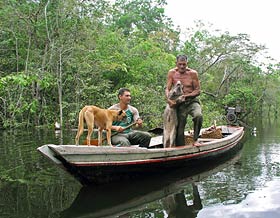
July 24, 2006

I’ve always liked the idea that a man named Ralph Wetzel discovered one of the newest large mammal species, the Chacoan peccary, quite recently.
In Cryptozoology A to Z, I wrote:
This “rangy big pig,” as University of Connecticut biology professor Ralph M. Wetzel characterized his 1974 discovery, was a big surprise – a Pleistocene Epoch survivor of a species thought to have died out 10,000 years ago. The Chacoan peccary, a relative of pigs, boars, and warthogs, weighed in at more than 100 pounds, the largest and most unusual of the three known peccaries. Wetzel found it in the wilds of Paraguay after interviewing the natives about a mysterious pig variously called tagua, pagua, or cure’-buro (“donkey-pig”). Wetzel stated that it differed from other known peccaries by its larger size; longer ears, snout, and legs; and proportionately shorter tail. In 1975, Wetzel formally named the species Catagonus wagneri, the Chacoan peccary or tagua.
Now comes word, via Darren Naish, of a new species of giant peccary:
…here’s the big news. While the 1975 discovery of the Chacoan peccary was a major zoological discovery – indeed one of the most significant mammalogical discoveries of the 20th century – it seems that history is repeating itself, for there is now a fourth living peccary species: the Giant peccary. As in the case of the Chacoan peccary, this new species appears to have been discovered by listening to local people: in this case the Caboclos people (descendants of rubber collectors) of the Brazilian Amazon. And the discover is Mark Van Roosmalen, the Dutch primatologist well known for the many new species of primate he has discovered (about 20) within recent years.
After learning of the fabled new peccary, apparently larger than the documented species, Van Roosmalen set off with GEO magazine author and film maker Lothar Frenz and two photographers. And after four days of waiting in a hide they were rewarded with views of a group of four of the animals. Good photos were obtained, and one is reproduced here (at top). The animals look distinct from the other living peccaries – they’re most like Collared peccaries but larger and without the collar, and they’re reported to be even bigger than Chacoan peccaries, hence the name Giant peccary.
German newspapers first reported the successful observation of live Giant peccaries in June 2004, and the news was apparently held back in order to coincide its release with the airing of Frenz’s documentary on the expedition. So far as I can tell however, Karl Shuker was first to break the news as he mentioned it in his 2002 book The New Zoo. Citing personal communication from Van Roosmalen, Shuker implied that the Giant peccary had first been encountered in January 2000. It also seems that Van Roosmalen and Frenz observed the successful capture and killing of one of the animals: an article in Suiform Soundings (The newsletter of the IUCN/SSC Pigs, Peccaries, and Hippos Specialist Group. Formerly Asian Wild Pig News) entitled ‘New mammal discovered in South America – and eaten’ stated that ‘Frenz said he and Van Roosmalen abstained from trying the meat, but collected some of the remains for a genetic study’. The GEO article includes a photo of hunters with a dead Giant peccary (image below), so maybe this is the same individual that Frenz and Van Roosmalen watched being eaten.

GEO magazine published an article (in German) on the discovery in 2004, and in December 2005 Suiform Soundings published an English version (Carstens 2005). I don’t know if Van Roosmalen is planning to publish a description based only on the meat sample he collected (species have been described from photos and tissue samples before, the best known case being that of the Bulo Burti boubou Laniarius liberatus), or if he’s waiting until better material is obtained, but it seems that we have here the valid discovery of a large, terrestrial mammal. That’s a big deal, though admittedly not as big a deal as so many people – zoologists included – still seem to think. Multiple new large mammals have been described in recent years, and there’s every reason to think that more such discoveries will occur in the future.
It is another good example of the work of cryptozoology leading to a new find of another animal species.
Thanks to Darren Naish for bringing this to the attention of Cryptomundo.
About Loren Coleman
Loren Coleman is one of the world’s leading cryptozoologists, some say “the” leading living cryptozoologist. Certainly, he is acknowledged as the current living American researcher and writer who has most popularized cryptozoology in the late 20th and early 21st centuries.
Starting his fieldwork and investigations in 1960, after traveling and trekking extensively in pursuit of cryptozoological mysteries, Coleman began writing to share his experiences in 1969. An honorary member of Ivan T. Sanderson’s Society for the Investigation of the Unexplained in the 1970s, Coleman has been bestowed with similar honorary memberships of the North Idaho College Cryptozoology Club in 1983, and in subsequent years, that of the British Columbia Scientific Cryptozoology Club, CryptoSafari International, and other international organizations. He was also a Life Member and Benefactor of the International Society of Cryptozoology (now-defunct).
Loren Coleman’s daily blog, as a member of the Cryptomundo Team, served as an ongoing avenue of communication for the ever-growing body of cryptozoo news from 2005 through 2013. He returned as an infrequent contributor beginning Halloween week of 2015.
Coleman is the founder in 2003, and current director of the International Cryptozoology Museum in Portland, Maine.
Filed under Breaking News, CryptoZoo News, Cryptozoology, Extinct, Eyewitness Accounts, Folklore, Forensic Science